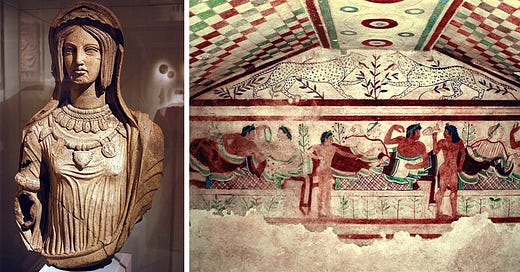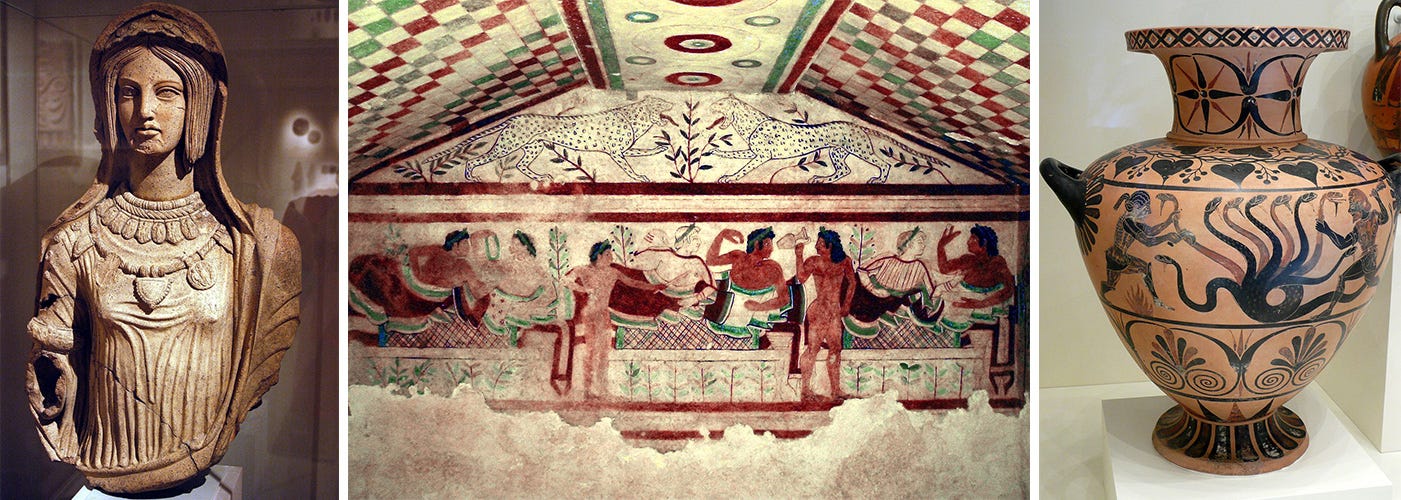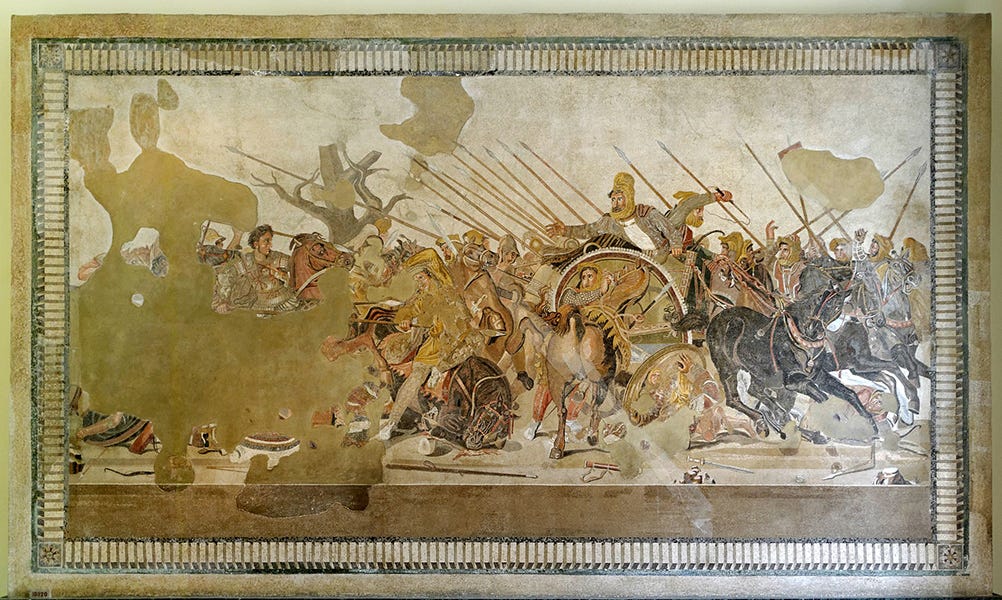The Mediterranean Iron Age: Art History 101
A brief introduction to the art of Rome, Egypt, and more
Last time we checked out the evolution of ancient Greek art as we know it today. The Mediterranean’s post-Alexander major power was that of the Romans.
The Roman Kingdom and Etruscan Art
The Etruscans (also known as Villanovans in their early stages) were Italy’s first Iron Age civilization, developing ironworking by 900 BC.
The Italian peninsula was home to several cultures in its early years:
There are several myths about the origins of the Roman people. In one legend, in the wake of the Trojan War, the hero Aeneas grouped up with other survivors and looked to begin a new nation. Their descendants included the twins Romulus and Remus, who were ordered to die so they wouldn’t threaten a local king’s rule. The twins were raised by a she-wolf until a shepherd adopted them. They eventually became leaders, overthrew the king, and set out to create their own city, deciding upon a region with seven hills. Arguments ensued over which hill to use and Remus was slain in this conflict. Romulus served as Rome’s first king from 753 to 716 BC, soon after the Greek Dark Ages of 1200-776 BC.
753 BC could be accurate, since there’s archeological evidence of Roman settlement and expansion from that time. We also see a transition from the Romans being inspired primarily by Etruscan art to more influence from the Greeks.
Etruscans passed many important ideas to the Romans. This included temples, sarcophagi, burial urns, death masks, togas, chariot racing, arches, and vaults. Some ideas, like their alphabet, stemmed from Greek contact.
Wood, bronze, and terracotta were common building materials, as only Classical Greece could afford widespread use of marble at the time. Influence from Egyptian and Greek culture is visible in Etruscan works, as most Mediterranean cultures were connected.
With the founding of Rome, a Roman Kingdom developed, and warfare soon spread across the peninsula.
Romans held Greek art in high esteem, especially after 212 BC. Roman artists often made copies or derivative works of Greek sculptures. Fortunately, this gave us a better picture of Greek art, since many original works didn’t survive the ravages of time. We have to rely on Roman versions and written records to prove their existence. And even before the Romans conquered the Greeks, the wealthy commissioned Greek works, to decorate country villas and more.
Both Etruscan and Greek artists were highly skilled, and the collision of both cultures led to the Romans having some of the world’s greatest works of the era.
As the art world evolved, the Romans developed their own style and national identity, as well as landmark inventions like concrete and domes.
The Roman Republic and Roman Empire
The Roman Kingdom became the Roman Republic in 509 BC after the overthrow of their short-lived monarchy.
480-300 BC is considered the peak of Etruscan art; their “classical” period. Their culture was soon absorbed by the Romans and became less important compared to Hellenistic/Greek art. By 200-100 BC, most of Rome’s sculptors were allegedly Greek, sometimes held as slaves.
The main difference between “Roman” and classical Greek sculpture is that the Romans were more interested in realism, as opposed to the idealism displayed in Greece. Faces take on more signs of age and wear, while bodies are less muscular and youthful.
The Romans soon became the Mediterranean’s prime power. They controlled nearly all of Italy by the start of the Punic Wars in 264 BC. The Roman world expanded from there, including the Achaean War (146 BC) which gave them control over Greece.
The Roman Empire
By most accounts, we can set the founding of the empire to 27 BC, when Gaius Julius Caesar Octavianus was declared princeps and Augustus. Rome was the largest and richest city in the Mediterranean around this time. This led to the so-called Pax Romana, viewed as Rome’s Golden Age (27 BC to 180 AD).
Emperor Augustus was one of history’s biggest art patrons, promoting everything from literature to monuments. He was quoted "I found a Rome of bricks; I leave to you one of marble." He, and other emperors, understood the value of political and religious symbolism.
De Architectura (30-20 BC) is one of the most important early resources on architecture. It compiled Greco-Roman knowledge on city planning, aqueducts, water mills, central heating, and more.
The Colosseum opened in 80 AD, a year after Mount Vesuvius buried Pompeii in ash.
Trajan's Column was completed in 113 AD.
The Arch of Septimius Severus dates back to 203 AD.
One Roman contribution to art was the idea of the equestrian statue. It wasn’t uniquely a Roman invention, but they were greater fans than most other cultures. Sculptors created at least 22 commemorative statues of war heroes and leaders in Rome (generally bronze) although none have survived except one of Marcus Aurelius from about 175 AD. The idea was given new life in the Renaissance, for example Giambologna’s 1598 statue of Grand Duke Cosimo I.
It’s impossible to overstate how much art flowed throughout the Roman Empire. Roads, bathhouses, glassware, silverware, jewelry, gemcutting, etc. But this article is long enough as it is.
For more examples of Julio-Claudian art, here’s a compilation of over 43,000 photos: https://www.flickr.com/groups/93273909@N00/
There are many dates for the fall of the Roman Empire. 476 AD is a popular choice; the Germanic king Odoacer overthrew the last Emperor of the Western half, Romulus Augustulus, and became King of Italy.
Christian art largely began emerging after it was legalized.in 313 AD with the Edict of Milan. Early Christian-Roman art include the marble Sarcophagus of Junius Bassus and the Dogmatic Sarcophagus (330-340). Earlier examples do exist, like the Dura Europos wall paintings (240) but such art was on the fringes of Roman society due to ongoing persecution. The Vienna Genesis (500-600 AD) is one of the earliest illustrated Bibles.
Byzantine art used more overt Christian symbolism while blending Greco-Roman and Eastern styles. More on that later.
An early mosaic masterpiece: the Alexander Mosaic from 120-100 BC.
The Egyptians
The Greeks felt a particularly close affinity with Egypt and you can see the influence in their art. Herodotus wrote in Histories that “the Egyptians deemed themselves to be the oldest nation on earth.” A little later, he recounted that Egyptian priests could trace their genealogy back 345 generations (Book 2, Chapter 143). An impressive achievement by anyone’s reckoning, even in modern times. The Near East undoubtedly had an influence on the younger Mediterranean civilizations.
After the Bronze Age Collapse (1200 BC), the New Kingdom (1550-1069 BC) was followed by a period of decline. This was effectively the end of independent Egyptian art development. Their art retreated slightly into familiar, traditional, styles during the decline. Egypt was then conquered by the Assyrians, and the Persians, before Alexander the Great (356-232 BC) swept through the world. Also see: the Ptolemaic Kingdom.
Then came the Roman Period (30 BC to 619-641 AD) which was followed by the Muslim conquest of Egypt. The Muslims remained largely in control of Egypt until the Medieval era, where the Black Death killed 40% of the population, and the Ottoman Turks conquered Egypt in 1517 AD.
The Fayum mummy portraits from the Roman era are one example of evolving cultural norms. You can see how deeply Egyptian art was affected by Greek and Roman culture.
From The Met:
“For the first century following the Roman conquest, Egypt functioned in the Mediterranean world as an active and prosperous Roman province… produced papyrus, glass, and various finely crafted minor arts that were exported to the rest of the Roman empire. Its deserts yielded a variety of minerals, ores, and fine stones such as porphyry and granite, which were brought to Rome to be used for sculpture and architectural elements.”
“The conquest of Egypt and its incorporation into the Roman empire inaugurated a new fascination with its ancient culture. Obelisks and Egyptian-style architecture and sculpture were installed in Roman fora.”
Outside of Egypt, other Mediterranean-adjacent cultures included those of Mesopotamia.
The Near East
The Neo-Assyrian Empire controlled most of the Near East at the time of Rome’s founding, followed by the Neo-Babylonian Empire.
Assyrian lion hunt reliefs, from around 645 BC, are some of the earliest examples of “narrative sculpture”–one method of telling stories (often mythological). The Assyrians preferred the bas-relief (low) style of carving, where the subject doesn’t protrude much. Paint was used to emphasize figures. The Egyptians by contrast liked the sunk relief where you carve lines directly into the stone.
The famous Ishtar Gate was built around 575 BC under King Nebuchadnezzar II.
King Cyrus the Great founded the Achaemenid Empire, also known as the first Persian empire. Initially a vassal to the Median Empire, he led a revolt in 553-550 BC and overthrew them. From there his forces spread across the Near East, eventually leading to one of the world’s largest empires.
However, the Persians never united the region under a singular culture. It was a multi-state empire of semi-autonomous regions. This resulted in some different art styles, including the creation of a new Persian style.
Although Alexander the Great conquered the Achaemenid Empire by 330-328 BC, and more Hellenistic influences entered Mesopotamian art, the region kept much of their traditions. It isn’t as much of a difference as, say, Egypt.
The End of the Iron Age
The end of the Iron Age varies by region, so there isn’t a clean transition out of “ancient art.” Historians often put it after the collapse of the unified Roman Empire (395-476 AD). That’s what changed Europe enough so that the Medieval Era could begin.
The final two Seven Wonders, the Colossus of Rhodes and the Pharos Lighthouse of Alexandria, were built near the end of this era.
The Roman Republic (and Roman Empire) had a lasting influence on Europe which continues to the present day. Many cultures have considered themselves spiritual successors to the empire, including the United States of America.
Next up: Byzantine Art and the Middle Ages, from approximately 300-1500 AD. Or maybe we’ll explore the non-Mediterranean Iron Age first.





















